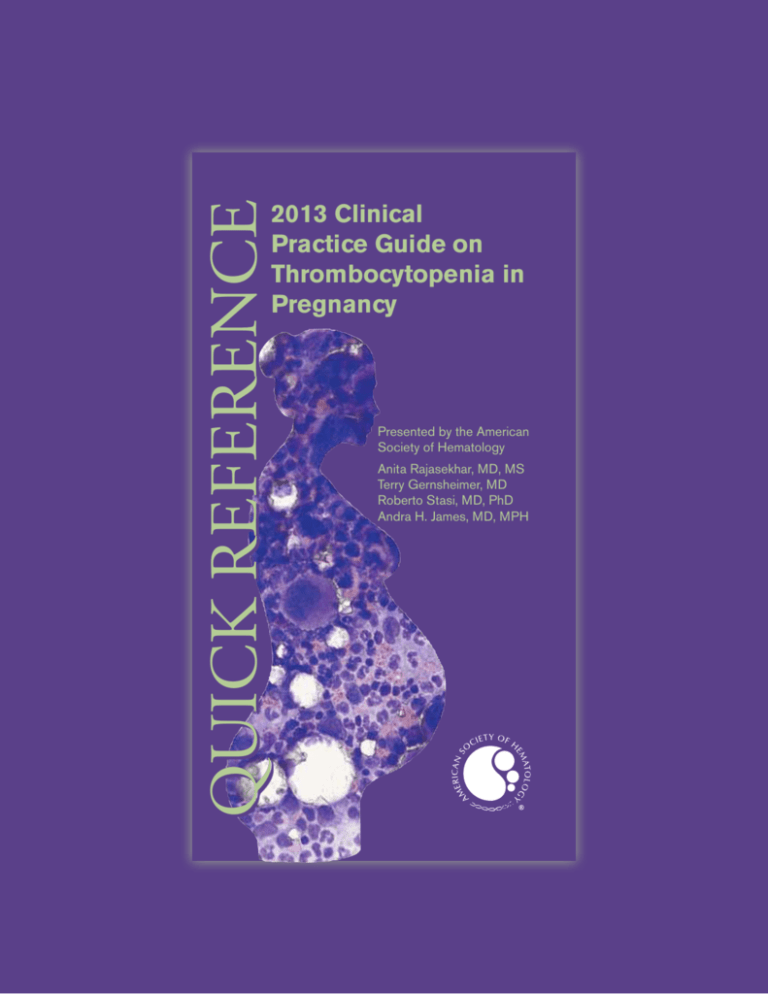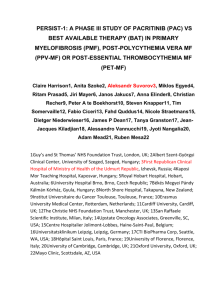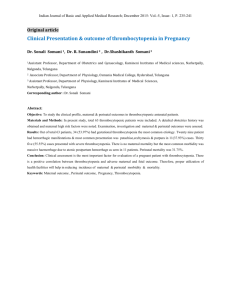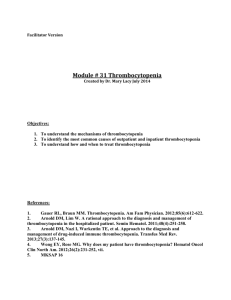
QUICK REFERENCE
2013 Clinical
Practice Guide on
Thrombocytopenia in
Pregnancy
2013 Clinical
Practice Guide on
Thrombocytopenia
in Pregnancy
Presented by the American
of Hematology
Presented bySociety
the American
Anita Rajasekhar, MD, MS
Society of Hematology
Terry Gernsheimer, MD
Anita Rajasekhar,
MD,
MSMD, PhD
Roberto
Stasi,
Andra H.MD
James, MD, MPH
Terry Gernsheimer,
Roberto Stasi, MD, PhD
Andra H. James, MD, MPH
I.
Introduction to Thrombocytopenia in Pregnancy
• Thrombocytopenia is second to anemia as the most common hematologic
abnormality encountered during pregnancy.
• The prevalence of a platelet count < 150 x 109/L in the third trimester of
pregnancy is 6.6 to 11.6%.
• A platelet count of < 100 x 109/L, the definition for thrombocytopenia
adopted by the International Working Group, is observed in only 1% of
pregnant women.
The hematologist’s role is to:
• determine the cause
• advise in the management of thrombocytopenia
• help estimate the risk to the mother and fetus
II. Causes of Thrombocytopenia in Pregnancy
The hematologist is usually consulted in one of three scenarios:
1. pre-existing thrombocytopenia—most commonly, immune thrombocytopenia
(ITP)
2. decreasing platelet count or newly discovered thrombocytopenia in
pregnancy, which may or may not be related to pregnancy
3. acute onset of thrombocytopenia in the setting of severe preeclampsia,
the HELLP syndrome (hemolysis, elevated liver enzymes, low platelets) or
AFLP (acute fatty liver of pregnancy)
Table 1. Causes and Relative Incidence of Thrombocytopenia in Pregnancy
Pregnancy-specific
Not pregnancy-specific
Isolated throm- Gestational thrombocy- Primary ITP (1-4%)
topenia (70-80%)
Secondary ITP (<1%)*
bocytopenia
Drug-induced thrombocytopenia **
Type IIB von Willebrand disease **
Congenital thrombocytopenia **
Thrombocytopenia
associated
with systemic
disorders
Severe preeclampsia
(15-20%)
HELLP syndrome
(<1%)
AFLP (<1%)
TTP/HUS **
Systemic lupus erythematosus **
Antiphospholipid syndrome **
Viral infections **
Bone marrow disorders **
Nutritional deficiency **
Splenic sequestration (liver
diseases, portal vein thrombosis,
storage disease, etc) **
Thyroid disorders **
Tests that are not
recommended
*Consider if history of bleeding, family history of thrombocytopenia, or unresponsive
to ITP therapy
^ Appropriate to rule out autoimmune thrombocytopenia (Evans syndrome) if
anemia and reticulocytosis present
†
In the setting of recurrent infections, low immunoglobulin levels may reveal a
previously undiagnosed immunodeficiency disorder (e.g. common variable immune
deficiency)
Reference: Adapted from Gernsheimer T, James AH, Stasi R, How I treat thrombocytopenia in pregnancy. Blood. 2013;121(1):38-47; and Neunert C, Lim W, Crowther M, Cohen
A, Solberg L, Jr., Crowther MA. The American Society of Hematology 2011 evidencebased practice guideline for immune thrombocytopenia. Blood. 2011;117(16):41904207; and Provan D, Stasi R, Newland AC, et al. International consensus report on
the investigation and management of primary immune thrombocytopenia. Blood.
2010;115(2):168-186.
IV. ITP and Its Management in Pregnancy
penia in Pregnancy: Gestational Thrombocytopenia
Table 2. Basic Laboratory Evaluation of Thrombocytopenia in Pregnancy
Recommended tests Complete blood count
Reticulocyte count
Peripheral blood smear
Liver function tests
Viral screening (HIV, HCV, HBV)
Tests to consider if
clinically indicated
Antiphospholipid antibodies
Anti-nuclear antibody (ANA)
Thyroid function tests
H. pylori testing
DIC testing—prothrombin time (PT), partial thromboplastin
time (PTT), fibrinogen, fibrin split products
VWD type IIB testing*
Direct antiglobulin (Coombs) test^
Quantitative immunoglobulins †
Second line therapy
(for refractory ITP)
Combined corticosteroids and IVIg
Splenectomy (second trimester)
Anti-D immunoglobulin [C]
Azathioprine [D]**
Not recommended, but use Cyclosporine A [C]
in pregnancy described
Dapsone [C]
Thrombopoietin receptor agonists [C]
Campath-1H [C]
Rituximab [C]
Contraindicated
Mycophenolate mofetil [C]
Cyclophosphamide [D]
Vinca alkaloids [D]
Danazol [X]
III. Decreasing Platelet Count or Newly Discovered Thrombocyto-
Oral corticosteroids—initial response 2-14 days, peak
response 4-28 days [C or D]
IVIg—initial response 1-3 days, peak response 2-7
days [C]
Relatively contraindicated
Reference: Adapted from Gernsheimer T, James AH, Stasi R, How I treat thrombocytopenia in pregnancy. Blood. 2013;121(1):38-47.
First line therapy
Third line therapy
** Rare (probably <1%)
• Accounts for 70-80% of cases of thrombocytopenia in pregnancy and is
typically characterized by a platelet count > 70 x 109/L.
• Commonly occurs in the mid-second to third trimester.
• No confirmatory tests; diagnosis of exclusion.
• Mechanism unknown, but hemodilution and accelerated clearance are
postulated.
• No special management is required, but platelet count < 70 x 109/L
warrants an investigation for an alternative etiology.
• Typically resolves within six weeks postpartum, but may recur with
subsequent pregnancies.
• Not associated with neonatal thrombocytopenia.
• Women with no bleeding manifestations and platelet counts ≥ 30 x 109/L
do not require any treatment until 36 weeks gestation (or sooner if delivery
is imminent).
• If platelet counts are < 30 x 109/L or clinically relevant bleeding is present,
first line therapy is oral corticosteroids or intravenous immunoglobulin (IVIg).
• The recommended starting dose of IVIg is 1 g/kg.
• In pregnancy, the oral corticosteroids prednisone and prednisolone are
preferred to dexamethasone, which crosses the placenta more readily.
• While “The American Society of Hematology 2011 Evidence-Based Practice
Guideline for Immune Thrombocytopenia” recommends a starting dose of
prednisone of 1mg/kg daily, there is no evidence that a higher starting dose
is better than a lower dose. Therefore, other experts recommend a starting
dose of 0.25 to 0.5 mg/kg daily.
• Medications are adjusted to maintain a safe platelet count (see below).
Table 3. Therapeutic Options for Management of ITP During Pregnancy*
*Secondary ITP includes isolated thrombocytopenia secondary to some infections
(HIV, HCV, H. pylori) and to other autoimmune disorders such as systemic lupus
erythematous.
Antiplatelet antibody testing
Bone marrow biopsy
Thrombopoeitin (TPO) levels
*FDA-designated pregnancy category in brackets [ ]; C = Studies in animals show
risk, but inadequate studies in human fetuses. Benefit may justify risk; D = Evidence
of risk in human fetuses. Benefit may justify risk; X = Studies in animals or human
fetuses demonstrate abnormalities. Risk of harm outweighs benefits.
**Used for other disorders during pregnancy
Reference: Adapted from Gernsheimer T, James AH, Stasi R, How I treat thrombocytopenia in pregnancy. Blood. 2013;121(1):38-47; and Neunert C, Lim W, Crowther M, Cohen
A, Solberg L, Jr., Crowther MA. The American Society of Hematology 2011 evidencebased practice guideline for immune thrombocytopenia. Blood. 2011;117(16):41904207; and Provan D, Stasi R, Newland AC, et al. International consensus report on
the investigation and management of primary immune thrombocytopenia. Blood.
2010;115(2):168-186.
V. Management of ITP at the Time of Delivery
• Current recommendations aim for a platelet count of ≥ 50 x 109/L prior
to labor and delivery as the risk of cesarean delivery is present with every
labor.
• The minimum platelet count for the placement of regional anesthesia is
unknown and local practices may differ. Many anesthesiologists will place a
regional anesthetic if the platelet count is ≥ 80 x 109/L.
• While platelet transfusion alone is generally not effective in ITP, if an
adequate platelet count has not been achieved and delivery is emergent,
platelet transfusion in conjunction with IVIg can be considered.
• For a woman whose platelet count is < 80 x 109 but has not required
therapy during pregnancy, oral prednisone (or prednisolone) can be started
10 days prior to anticipated delivery at a dose of 10-20 mg daily and titrated
as necessary.
• Given the difficulty predicting severe thrombocytopenia in neonates and
the very low risk of intracranial hemorrhage (<1.5%) or mortality (<1%),
the mode of delivery should be determined by obstetric indications.
Percutaneous umbilical blood sampling (PUBS) or fetal scalp blood
sampling is not helpful in predicting neonatal thrombocytopenia, is
potentially harmful, and is, therefore, not recommended.
• The infant nadir platelet count occurs 2-5 days after delivery and a
spontaneous rise occurs by day 7.
• Women with ITP are at an increased risk of venous thromboembolism, and
some form of postpartum thromboprophylaxis should be considered.
Reference: Gernsheimer T, James AH, Stasi R, How I treat thrombocytopenia in
pregnancy. Blood. 2013;121(1):38-47; and Provan D, Stasi R, Newland AC, et al.
International consensus report on the investigation and management of primary immune
thrombocytopenia. Blood. 2010;115(2):168-186; and Neunert C, Lim W, Crowther
M, Cohen A, Solberg L, Jr., Crowther MA. The American Society of Hematology
2011 evidence-based practice guideline for immune thrombocytopenia. Blood.
2011;117(16):4190-4207.
VI. Acute Onset of Thrombocytopenia in the Setting of Severe
Preeclampsia, the HELLP Syndrome (hemolysis, elevated liver
enzymes, low platelets), or AFLP (acute fatty liver of pregnancy)
A. Severe Preeclampsia
1. Preeclampsia, which affects 5-8% of pregnant women, is diagnosed when:
• a systolic BP ≥ 140 mm Hg or diastolic BP ≥ 90 mm Hg is present
• accompanied by proteinuria, defined as urinary excretion ≥ 0.3 g
protein/24-hour
• after 20 weeks of gestation
• in a woman with previously normal blood pressure
2. Eclampsia is new-onset grand mal seizures in a woman with preeclampsia.
3. Superimposed preeclampsia may develop in a woman with a history of
chronic hypertension and is manifested by:
• development of, or a sudden increase in, proteinuria after 20 weeks of
gestation
• a sudden increase in hypertension after 20 weeks gestation, or
• the development of the HELLP syndrome
4. Severe preeclampsia is diagnosed when any one of a number of different
criteria are met. One of these is thrombocytopenia. Approximately 0.51.5% of all women develop a platelet count < 100 x 109/L at term, while
0.05-0.1% experience a platelet count < 50 x 109/L.
Reference: ACOG Practice Bulletin. Diagnosis and management of preeclampsia
and eclampsia. Number 33, January 2002. Obstet Gynecol. 2002;99(1):159-167;
and Burrows, R.F. and J.G. Kelton, Fetal thrombocytopenia and its relation to maternal
thrombocytopenia. N Engl J Med., 1993. 329(20): p. 1463-1466; and Sainio, S., et al.,
Maternal thrombocytopenia at term: a population-based study. Acta Obstet Gynecol
Scand, 2000. 79(9): p. 744-9; and Boehlen, F., et al., Platelet count at term pregnancy: a
reappraisal of the threshold. Obstet Gynecol, 2000. 95(1): p. 29-33.
B. HELLP Syndrome
HELLP syndrome, which affects 0.6% of pregnant women, is a variant
of preeclampsia. However, in 15-20% of cases of HELLP syndrome, no
hypertension or proteinuria is present. 70% of cases occur in the late second
or third trimester; the remainder occur postpartum.
• Criteria for AFLP from case series and expert opinion were used in a
prospective study from Southwest Wales (the “Swansea Criteria”) and have
subsequently been used in other studies. Six or more of these criteria in
the absence of another explanation were required for a diagnosis of AFLP.
Table 5. The Swansea Criteria for the Diagnosis of AFLP—6 Necessary
Vomiting
Leukocytosis
Abdominal pain
Ascites or bright liver on ultrasound scan
Polydipsia/polyuria
Elevated transaminases
Encephalopathy
Elevated ammonia
Elevated bilirubin
Renal impairment
Hypoglycemia
Coagulopathy
Elevated uric acid
Microvesicular steatosis on liver biopsy
Reference: Knight M, Nelson-Piercy C, Kurinczuk JJ, Spark P, Brocklehurst P. A prospective national study of acute fatty liver of pregnancy in the UK. Gut. 2008;57(7):951-956.
D. Management of Severe Preeclampsia, the HELLP Syndrome, or AFLP with
Thrombocytopenia
1. Obstetric management
• Treatment is delivery unless the patient is < 34 weeks gestation.
• If the patient is < 34 weeks gestation and maternal and fetal status are
otherwise reassuring, corticosteroids can be administered to accelerate
fetal lung maturity and the patient can be delivered in 48 hours.
• If the patient is < 34 weeks gestation and maternal and fetal status
are not reassuring, the patient should be delivered as soon as she is
stabilized.
• Magnesium sulfate is used to prevent seizures.
• Antihypertensives are used to control blood pressure.
2. Hematologic management
• Corticosteroids—may improve the platelet count and other laboratory
parameters more quickly, but have not been shown to improve long-term
maternal or fetal outcomes
• Supportive care with blood products—there is no contraindication to
platelet transfusion
• Therapeutic plasma exchange—if thrombocytopenia, hemolysis or renal
failure continues to worsen 48-72 hours postpartum
Reference: Gernsheimer T, James AH, Stasi R, How I treat thrombocytopenia in pregnancy. Blood. 2013;121(1):38-47; and Woudstra DM, Chandra S, Hofmeyr GJ, Dowswell
T. Corticosteroids for HELLP (hemolysis, elevated liver enzymes, low platelets) syndrome
in pregnancy. Cochrane Database Syst Rev. 2010(9).
VII. Thrombotic Thrombocytopenia Purpura (TTP)/Atypical Hemolytic Uremic Syndrome (aHUS)
• Differentiating between severe preeclampsia, HELLP, AFLP, or evolving
TTP/aHUS precipitated by pregnancy may be difficult (see Table 6).
• While the use of eculizumab has been described in paroxysmal nocturnal
hemoglobinuria during pregnancy, as yet no reports exist on eculizumab in
aHUS during pregnancy.
• Since therapeutic plasma exchange has been shown to improve the
outcome of all of these conditions, when plasma exchange is otherwise
indicated, diagnostic certainty is not required.
Table 6. Selected Causes of Thrombocytopenia During Pregnancy
Disease
Table 4. Diagnostic Criteria for HELLP Syndrome
Hemolysis
Sibai Criteria—1993
Martin Criteria—1991
Abnormal peripheral smear
(schistocytes)
LDH > 600 U/L
Bilirubin > 1.2 mg/dL
LDH > 600 U/L
Elevated liver AST > 70 U/L
enzymes
AST > 40 U/L
Low platelets Platelet count < 100 x 109/L
Platelet count < 150 x 109/L
Reference: adapted from Sibai BM, Ramadan MK, Usta I, Salama M, Mercer BM,
Friedman SA. Maternal morbidity and mortality in 442 pregnancies with hemolysis,
elevated liver enzymes, and low platelets (HELLP syndrome). Am J Obstet Gynecol.
1993;169(4):1000-1006.
C. Acute Fatty Liver of Pregnancy (AFLP)
• AFLP is a rare but serious condition of the third trimester (1 in 20,000
pregnancies).
• AFLP is characterized by elevated liver enzymes, elevated conjugated
bilirubin (frequently > 5mg/dL), and coagulopathy.
• Thrombocytopenia is present less than half of the time.
• AFLP has overlapping features with HELLP, but there is no well-established
definition of the condition that clearly differentiates it from HELLP.
InciDiagnostic
dence Features
During
Pregnancy
(%)
Laboratory Clinical
PathoFindings Symptoms physioland Physi- ogy
cal Exam
Comments
Gestational 5-9
thrombocytopenia
•Onset at late •PLT >70
second or
x 109
third trimester
•Normal PLT
outside of
pregnancy
•No neonatal
thrombocytopenia
•Typically
normal
•Unclear
•Diagnosis of
exclusion
•Resolution of
thrombocytopenia postpartum
•No fetal thrombocytopenia
ITP
•Onset any
trimester
•Thrombocytopenia
outside of
pregnancy
possible
•May have
signs of
bleeding,
bruising,
petechiae
•Antibody
induced peripheral PLT
destruction
•Decreased
thrombopoiesis
•Diagnosis of
exclusion
•May be associated with fetal
thrombocytopenia
<1
•PLT <100
x 109
•+/- large
PLT on PBS
Disease
InciDiagnostic
dence Features
During
Pregnancy
(%)
Laboratory Clinical
PathoFindings Symptoms physioland Physi- ogy
cal Exam
Comments
Preeclamp- 5-8
sia
•Onset in late • >0.3gm
second or
urine protein
third trimester / 24hrs
(>20 weeks
gestation)
•Systolic BP
≥ 140mmHg
or diastolic
BP ≥
90mmHg
•Systemic
endothelial
dysfunction
•Inadequate
placentation
HELLP
syndrome
<1
•70% onset in
late second or
third trimester
•30% onset
postpartum
•MAHA
•Elevated
LFTs
•Elevated
LDH
•Any or all
signs of
preeclampsia may be
present
•15-20%
of cases
no HTN or
proteinuria is
present
•Systemic
•Variant of
endothelial preeclampsia
dysfunction
•Inadequate
placentation
AFLP
<0.01
•Onset third
trimester
•PLT>50 x
109
•Elevated
LFTs, CR,
WBC, uric
acid,
ammonia
•Prolonged
PT/PTT,
decreased
fibrinogen
•Hypoglycemia
•RUQ abdominal pain
•Jaundice
•Nausea/
vomiting
•Hepatic encephalopathy
•On the
spectrum
with preeclampsia
•MAHA not
characteristic
•Conjugated bilirubin frequently
>5mg/dL
•Liver dysfunction more
significant than
in HELLP/preeclampsia
•Onset any
trimester, but
more common
during third
trimester or
post partum
•MAHA
•Elevated
CR
•Schistocytes on
PBS
•Fever
•Abdominal
pain
•Nausea/
vomiting
•Headache
•Visual
changes
•Altered mental status
•Congenital
deficiency /
inhibitor of
ADAMTS13
(TTP)
•Complement dysregulation
(aHUS)
•ADAMTS13
activity <5% in TTP
•LFT and BP
usually normal
TTP/aHUS <0.01
•Thrombocytopenia may
precede other
manifestations
of preeclampsia
•Can present
postpartum
Abbreviations:
PLT = platelet
PBS = peripheral blood smear
BP = blood pressure
MAHA = microangiopathic
hemolytic anemia
CR = creatinine
AFLP = acute fatty liver of
pregnancy
PT = prothrombin time
PTT = partial thromboplastin
time
LFTs = liver function tests
RUQ = right upper quadrant
LDH = lactate dehydrogenase
WBC = white blood cells
ADAMTS13 = a disintegrin
and metalloproteinase with
a thrombospondin type 1
motif, member 13
About this Clinical Quick Reference Guide
This guide is intended to provide the practitioner with clear principles and strategies for quality patient
care and does not establish a fixed set of rules that preempt physician judgment. For further information,
contact the ASH Department of Government Relations, Practice, and Scientific Affairs at 202-776-0544.
ASH website: www.hematology.org/practiceguidelines
© 2013 by the American Society of Hematology. All rights reserved.
American Society of Hematology
2021 L Street NW, Suite 900
Washington, DC 20036
www.hematology.org






